Did we say we were done talking about MIGS? Not a chance! After catching our breath (and getting some well-deserved rest), we’re excited to dive back in and share our favourite moments from MIGS 2024.
This event is always a standout for us, not just for the incredible panels and game reveals, but for the meaningful connections we get to make with all of you. Whether it’s shaking hands with old friends or meeting new faces, there’s nothing quite like being surrounded by fellow game enthusiasts, partners, and creators who share our passion for gaming.
Immersing in Innovation: Highlights from the MIGS 2024 Event Floor
This year’s Montreal International Game Summit delivered yet another exceptional experience. With the theme of Resilience driving the conversation, MIGS 2024 brought together some of the most brilliant minds in game development, along with indie studios, industry veterans, and passionate attendees from around the world (and Montreal)!
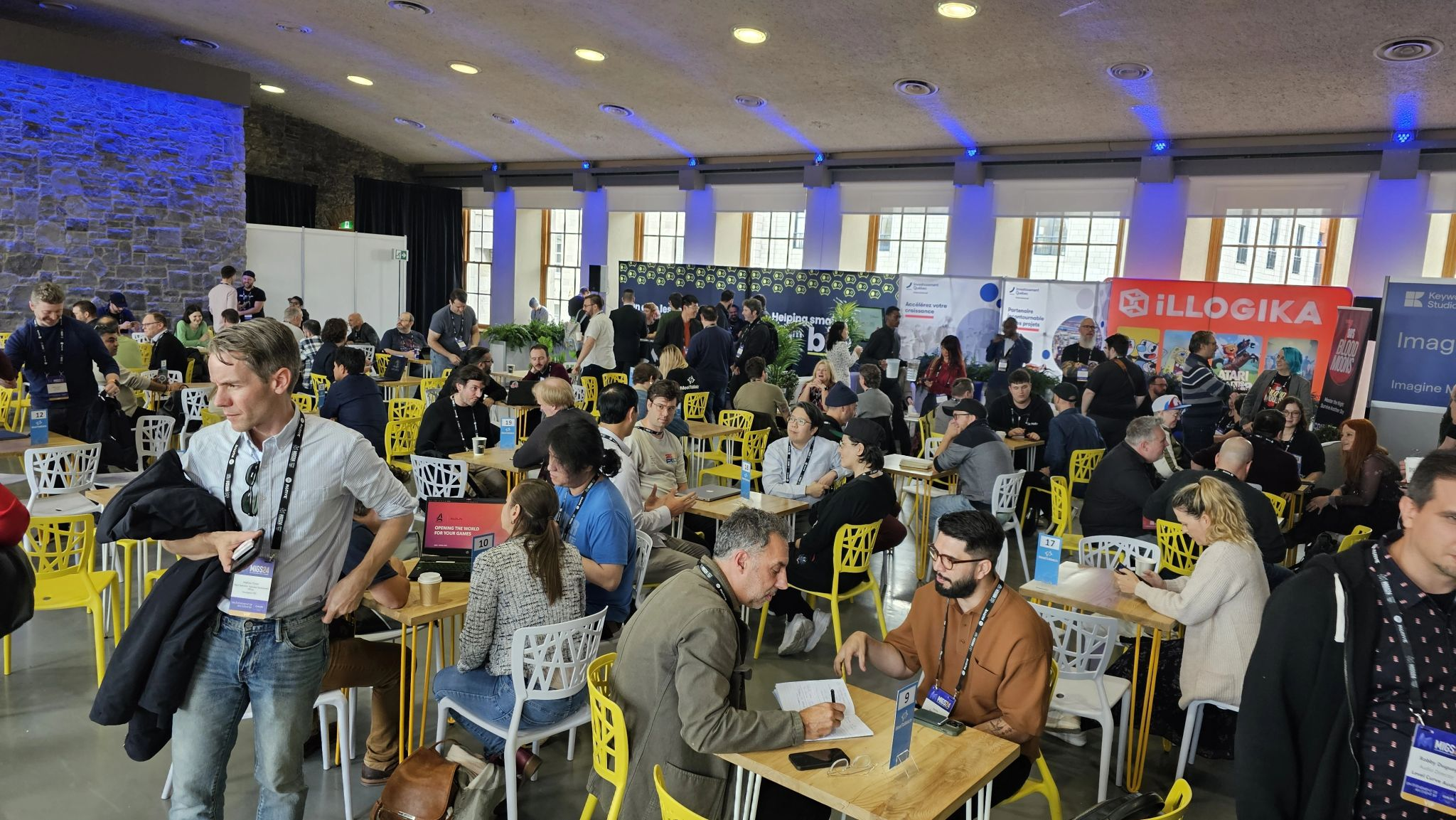 Meet2Match space - Official MIGS photo.
Meet2Match space - Official MIGS photo.
Now, we’re excited to share some of the standout moments we noticed, the invaluable insights, and the lessons that are still resonating with us weeks later. Mind you, despite wanting to, we couldn’t attend all the panels (Get ready, next year we will be everywhere!)
Game Rebellion’s Booth: Game Marketing Made Easy!
You have probably (and hopefully) seen our GameRebellion booth if you walked the floor. Whether you stopped by to say hello, ask about our latest projects, or simply caught a glimpse of us while exploring the event floor; we truly appreciated your presence.
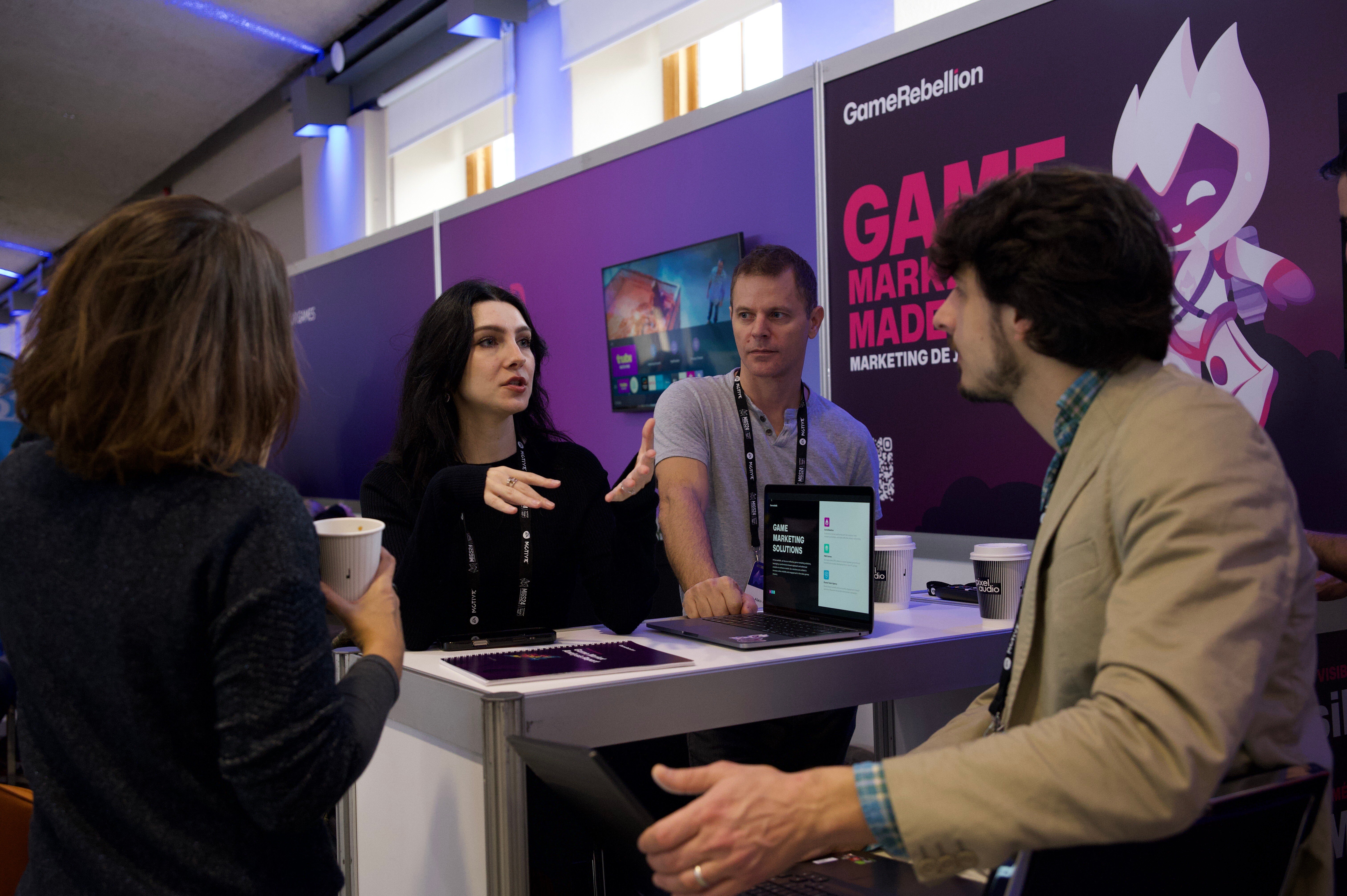 GameRebellion Booth, with Product Marketing Manager Manon Salaché and CTO Alain Carpentier in a meeting - Photo taken by Astrid Rousselin, all rights to GameRebellion.
GameRebellion Booth, with Product Marketing Manager Manon Salaché and CTO Alain Carpentier in a meeting - Photo taken by Astrid Rousselin, all rights to GameRebellion.
We were genuinely thrilled by the overwhelming interest from attendees. The booth was alive with dynamic conversations about game development, innovative game marketing strategies, and the overall future of indie gaming.
To give you a glimpse into our experience, we’ve created a video recap of MIGS 2024. It’s a quick snapshot of our fun and the invaluable moments that made this event truly great. And you? What was your highlight of MIGS?
A huge thank you to everyone who visited! It was an absolute pleasure to meet so many passionate creators and exchange ideas. We can’t wait to come back next year and see how the industry will evolve yet again !
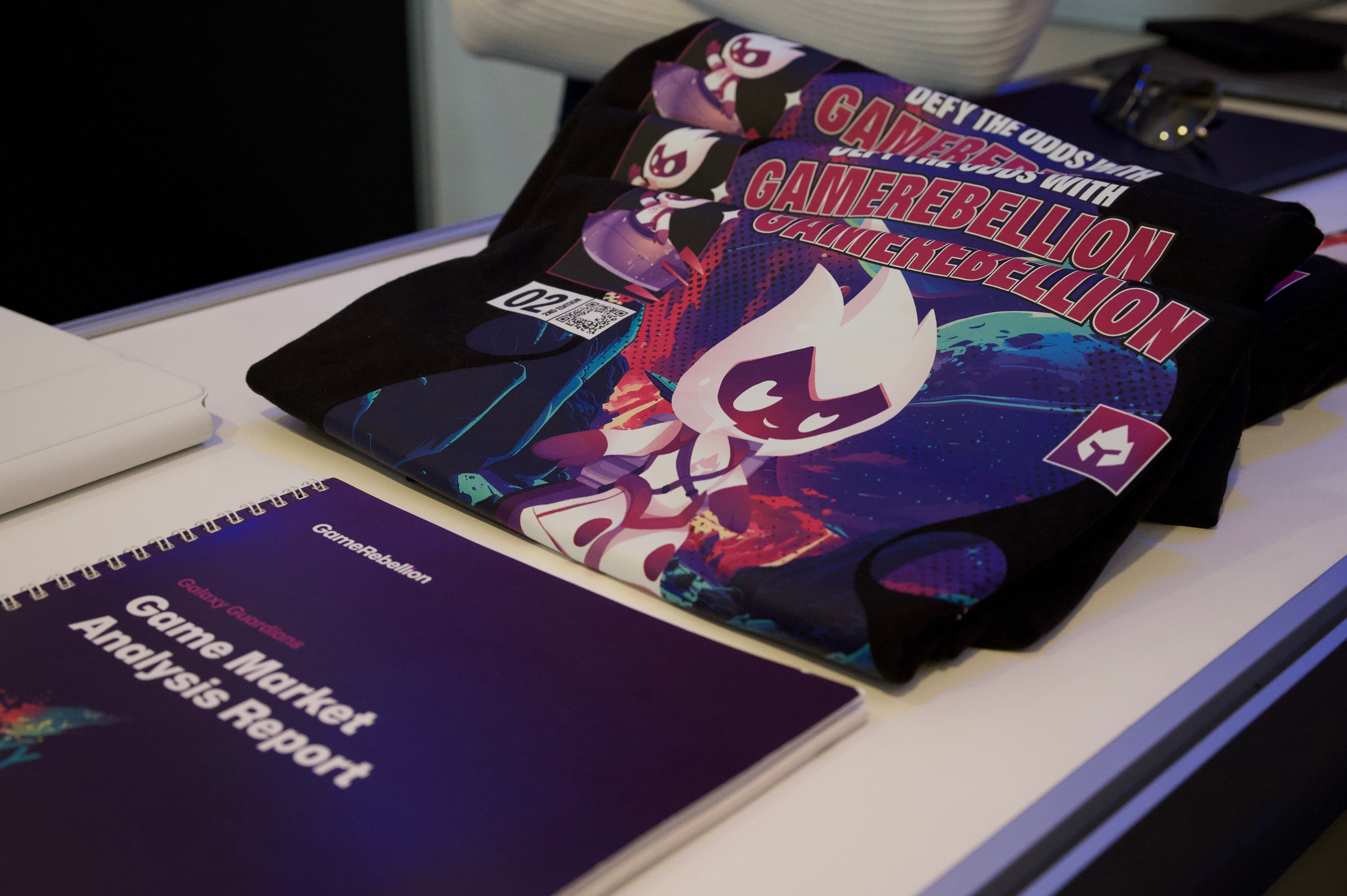 All GameRebellion merch you probably seen if you walked around MIGS floor - Photo taken by Astrid Rousselin, all rights to GameRebellion.
All GameRebellion merch you probably seen if you walked around MIGS floor - Photo taken by Astrid Rousselin, all rights to GameRebellion.
Discovering Creativity in the Indie Zone
We’re especially proud that Manon Salaché, our Product Development Manager, was part of the jury that selected the games showcased in the Loto Quebec Indie game zone. A special thank you to Emilien Roscanu from La Guilde des Jeux Vidéo for inviting us to contribute to such a meaningful initiative.
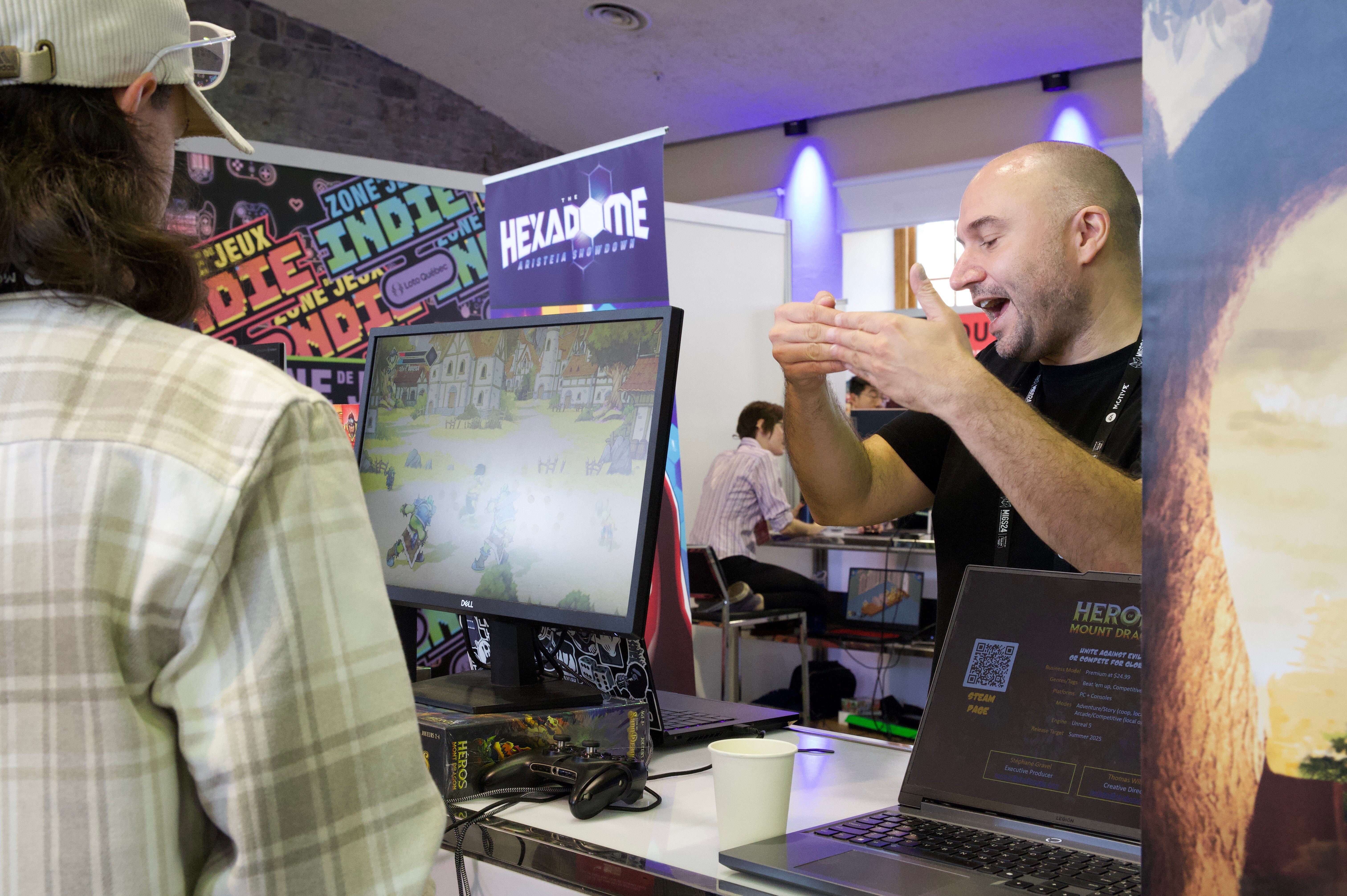 MIGS 2024 Indie Zone - Photo taken by Astrid Rousselin, all rights to GameRebellion.
MIGS 2024 Indie Zone - Photo taken by Astrid Rousselin, all rights to GameRebellion.
As described by MIGS, the Indie Zone exists to provide independent game developers with a stage to present their innovative projects to the industry. It’s a place where publishers, investors, and other creators can discover the latest trends in indie gaming and create partnerships and collaborations that might not happen anywhere else.
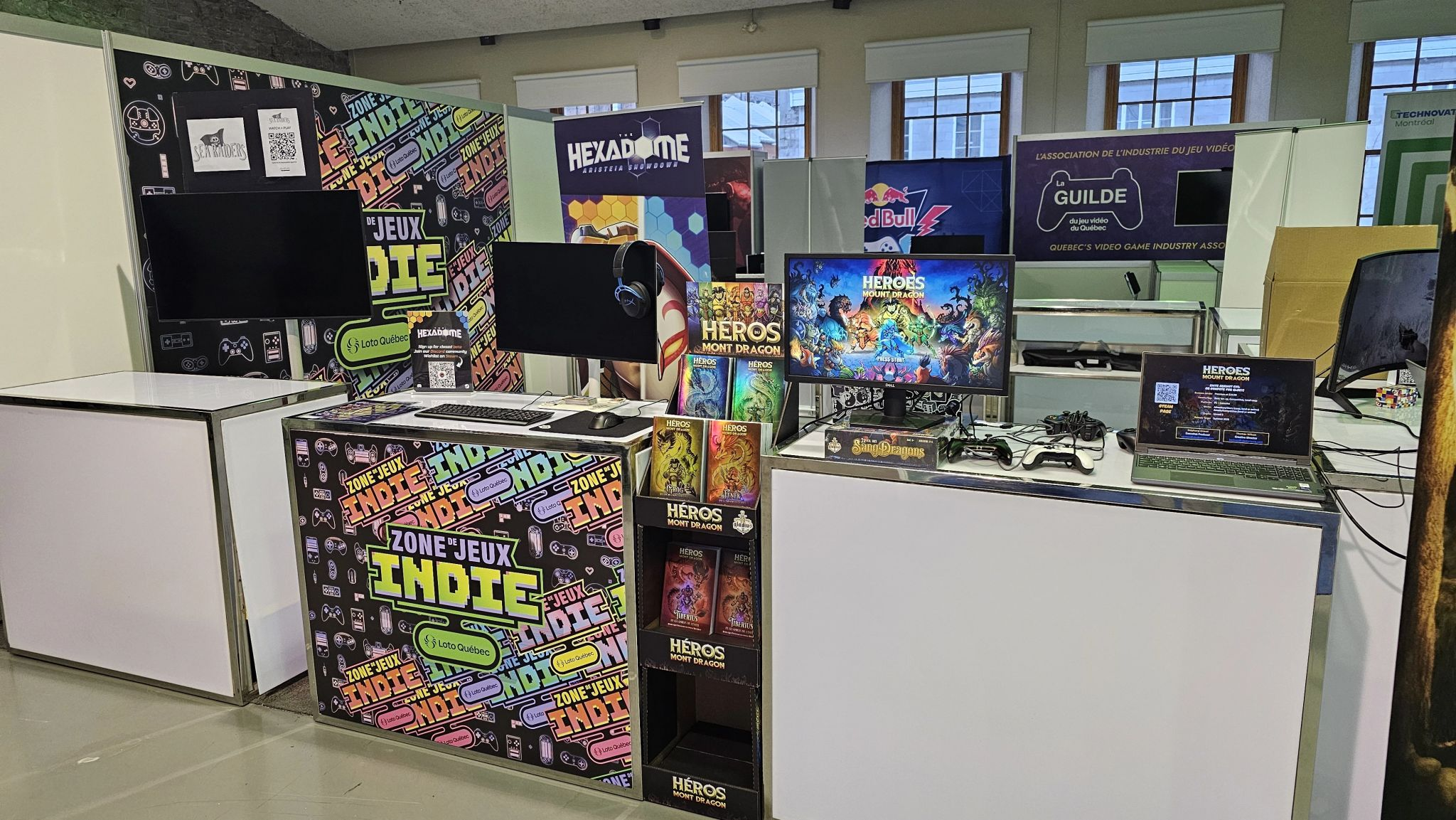 MIGS 2024 Indie Zone - Photo taken by MIGS official photographer.
MIGS 2024 Indie Zone - Photo taken by MIGS official photographer.
By emphasizing originality and diversity, the Indie Zone plays a vital role in driving the gaming industry forward by highlighting the unique voices that shape it.
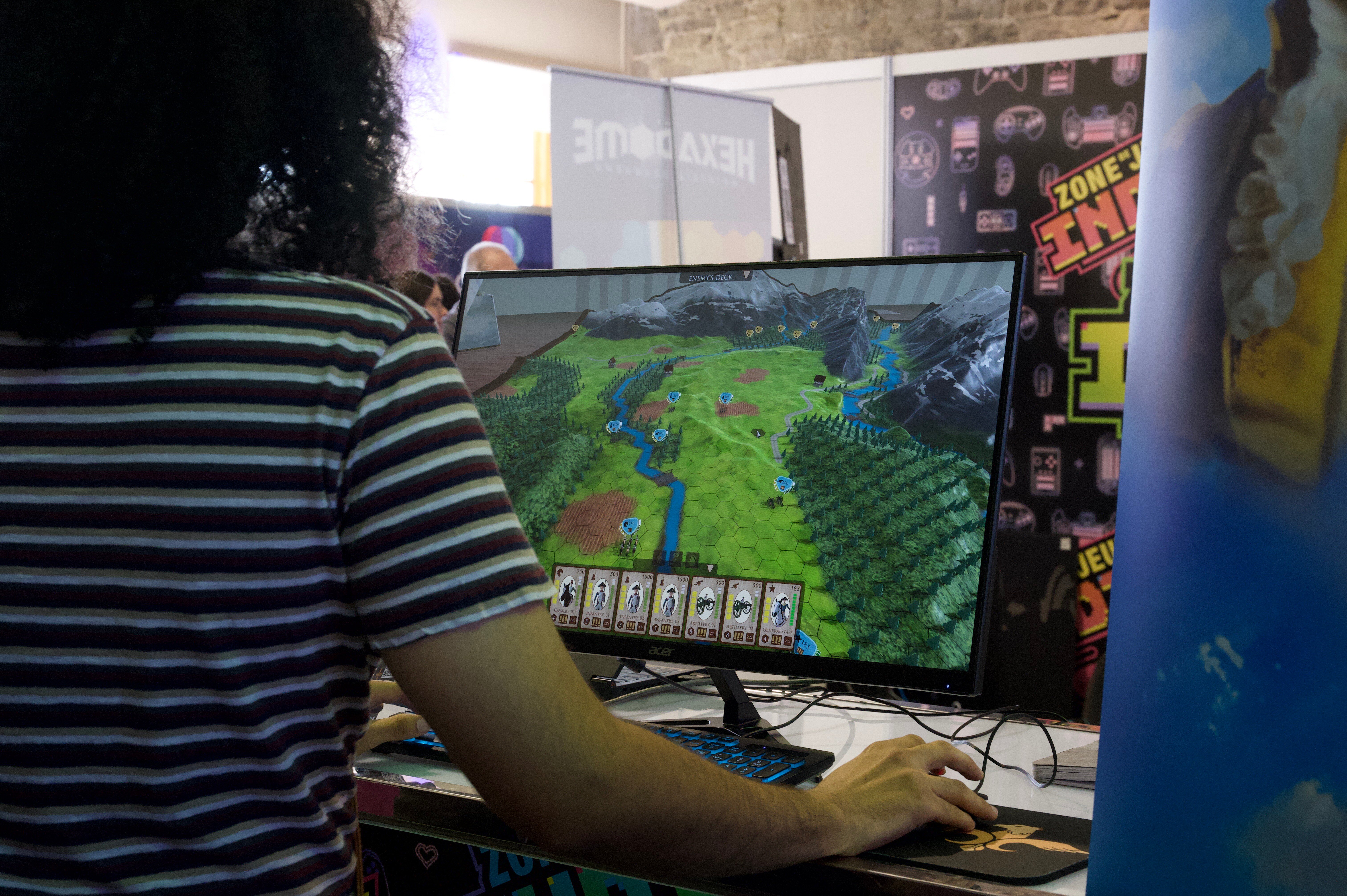 MIGS 2024 Indie Zone - Photo taken by Astrid Rousselin, all rights to GameRebellion.
MIGS 2024 Indie Zone - Photo taken by Astrid Rousselin, all rights to GameRebellion.
For us, exploring the Indie Zone was about more than just trying out games; it was about connecting with the minds behind them.
We had the chance to interview two inspiring indie studios: Jean-Bernard Rose, Programmer-Designer at Foretold Entertainment for their game Alamach, and Antabon Freddy Some, founder of Baoba Games and creator of Dion. They share their reasons for attending MIGS, which, include gaining visibility and leveraging the event as the perfect platform to connect with publishers and investors.
Speaking with developers like them, hearing their stories, and understanding the challenges they’ve overcome was a deeply motivating experience for us.
It reminded us why the indie community is so crucial to the overall gaming community as they bring a spirit of boldness, creativity & innovation, and resilience that keeps the industry fresh and constantly evolving.
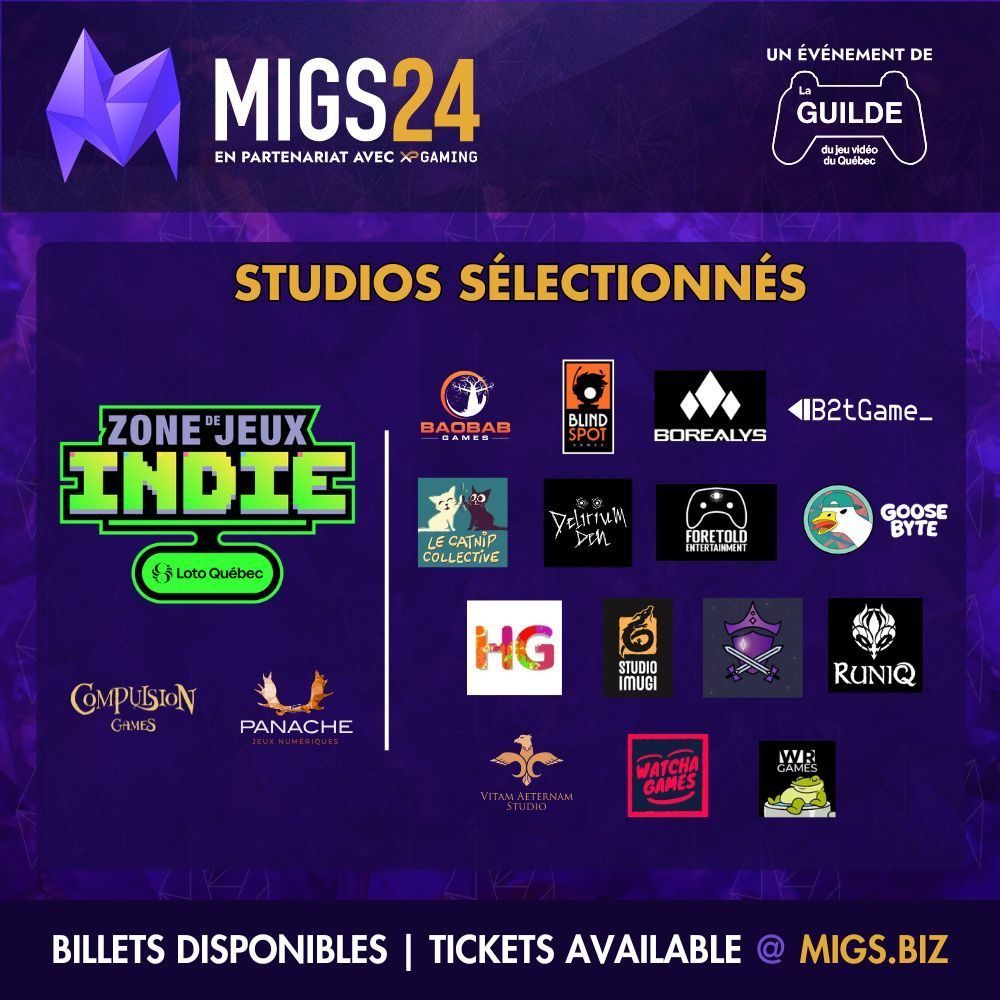 Attending the Indie zones: Hannagie Productions, Studio Invisible, Delirium Den, Vitam Aeternam Studio, Lablablab, Baobab Games, Goose Byte, Borealys Games, Studio Blindspot Inc., WoodRunner Games, Back to the Game, Studio Imugi, Watcha Games, STUDIOS SAKANA, RuniQ, Les jeux Bolodil inc., Studio ParaNoya, Le Catnip Collective, Foretold Entertainment, and Queensguard (Studio Lazulite).
Attending the Indie zones: Hannagie Productions, Studio Invisible, Delirium Den, Vitam Aeternam Studio, Lablablab, Baobab Games, Goose Byte, Borealys Games, Studio Blindspot Inc., WoodRunner Games, Back to the Game, Studio Imugi, Watcha Games, STUDIOS SAKANA, RuniQ, Les jeux Bolodil inc., Studio ParaNoya, Le Catnip Collective, Foretold Entertainment, and Queensguard (Studio Lazulite).
Leaving MIGS, we felt inspired to double down on our commitment to support indie projects. The Indie Zone reinforced for us that sometimes all it takes is a bit of extra support to help these creators turn their dreams into reality— and at Game Rebellion, we’re excited to be part of that journey.
Opening Panel: Understanding Market Dynamics in 2024
As you probably already know if you read us, MIGS 2024 kicked off with a powerful panel discussion titled Understanding Market Dynamics in 2024 to Ensure the Success of Your Game, led by industry heavyweights including Jason Della Rocca, Matthew Handrahan, Chloe Giusti, and Clara Sia. This session set the tone for the event, emphasizing the need for indie studios to keep adapting to the ever-evolving gaming market landscape, as it has always done.
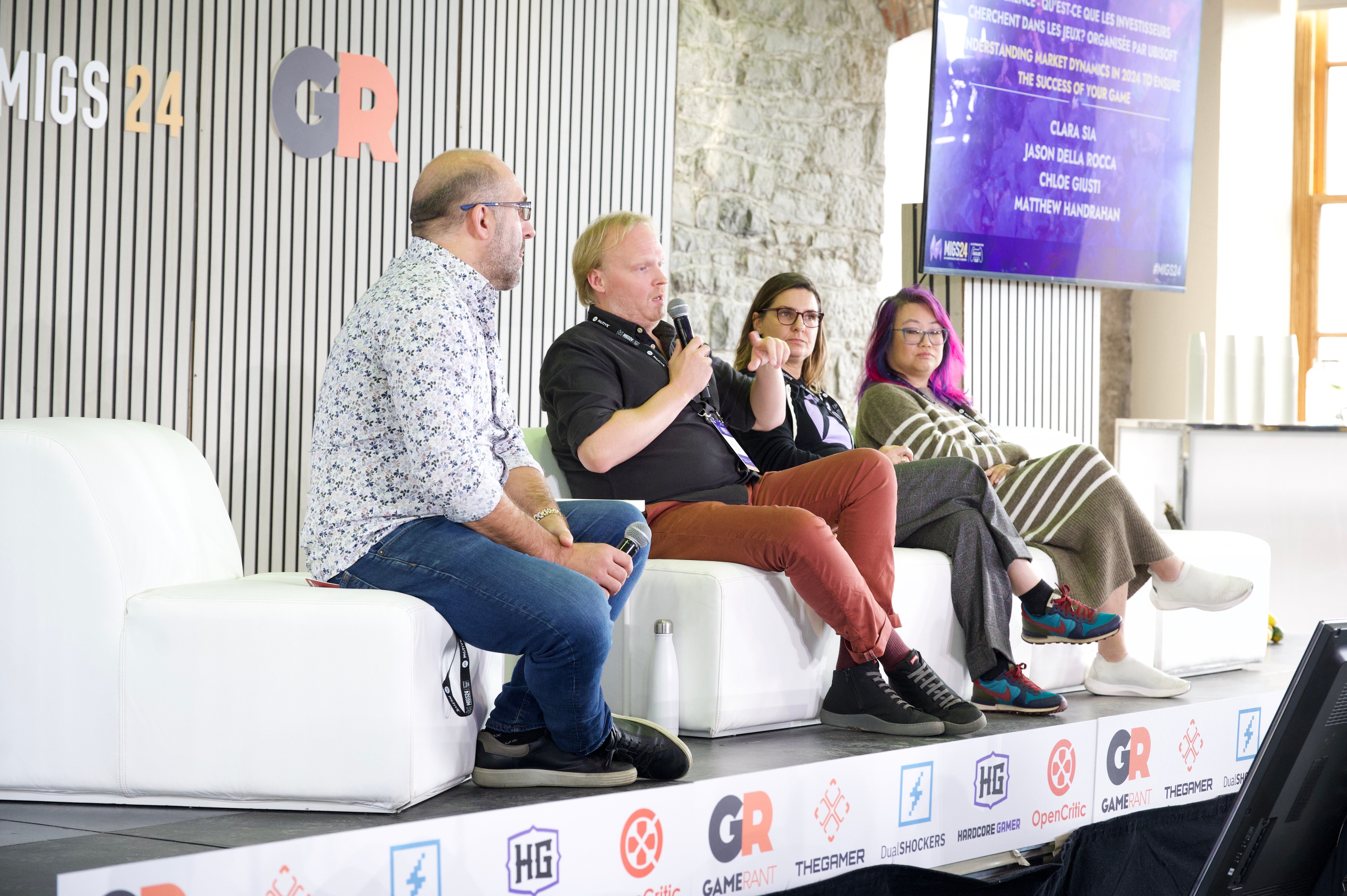 Experts (in order) Jason Della Rocca, Matthew Handrahan, Chloe Giusti, and Clara Sia presenting the panel “Understanding Market Dynamics in 2024 to Ensure the Success of Your Game” - Photo by Astrid Rousselin. All rights reserved to GameRebellion.
Experts (in order) Jason Della Rocca, Matthew Handrahan, Chloe Giusti, and Clara Sia presenting the panel “Understanding Market Dynamics in 2024 to Ensure the Success of Your Game” - Photo by Astrid Rousselin. All rights reserved to GameRebellion.
With insights into emerging trends, investment strategies, and market challenges, the panel offered invaluable advice on what makes a game appealing to both players and investors, and how to effectively pitch your game to attract publishers and investors alike.
If you’re curious about the key takeaways and want to dive deeper, check out our detailed article here for a breakdown of all the insights shared during this session.
Indie Game Pitch Competition: Inspiring Innovation
One of the most electrifying moments at MIGS 2024 was the Indie Game Pitch Competition. Like every year, five indie studios took the stage, presenting their games to a live audience and a panel of seasoned judges. The winning game, Love is a roguelite from itan1studios,** pitched by Evelyn Weech, captivated everyone with its unique mechanics and immersive storytelling that blends humour into its tactical turn-based deck builder (set within a procedurally generated love story) We listened to every pitch, and each one brought its own unique angle tailored to the game’s mechanics and genre, to captivate the audience; and more importantly, the judges.
The competition shows the critical importance of a pitch that’s not only clear and engaging but also shines a spotlight on the unique elements that set a game apart. From innovative gameplay mechanics to captivating storylines, each presentation showed originality and the passion of the team behind it.
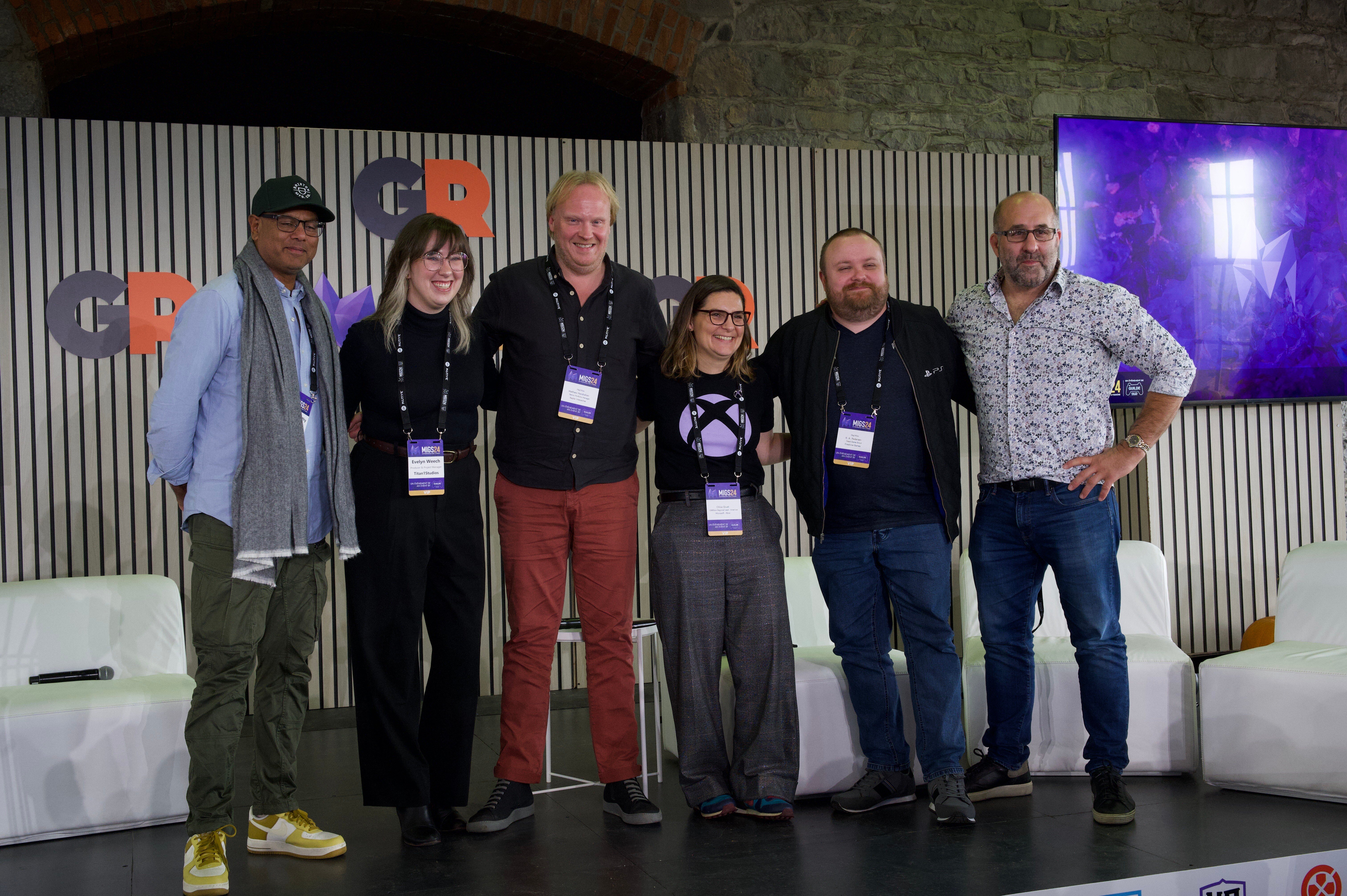 Judge panels for the Indie pitch competition, including Jason Della Rocca (far right), K.A. Pederson (right) Chloe Giusti (center right), Matthew Handrahan (center left), and the pitch competition winner Evelyn Weech for Love is a roguelite from Titan1studios - Photo taken by Astrid Rousselin, all rights to GameRebellion.
Judge panels for the Indie pitch competition, including Jason Della Rocca (far right), K.A. Pederson (right) Chloe Giusti (center right), Matthew Handrahan (center left), and the pitch competition winner Evelyn Weech for Love is a roguelite from Titan1studios - Photo taken by Astrid Rousselin, all rights to GameRebellion.
The judges emphasized that a great pitch isn’t just about selling your game; it’s about communicating your vision and convincing investors to believe in its potential.
If you’re looking to refine your own pitch and capture that magic, don’t miss our in-depth article filled with tips and takeaways from the experts at MIGS. Discover how to craft the perfect pitch.
Deep Dive Panels: Expert Tips for Growth and Game Development
Unlocking Growth Through Creator Programs
The panel on Creator Programs for Growth: Increasing Retention and Reactivation in Gaming ****led by industry veterans Philippe-Olivier Crepin, Carl-Edwin Michelle, and Travis Neiderhiser, offered a deep dive into how creator programs can drive sustained growth, retention, and reactivation in gaming. The discussion centered around the crucial role content creators play in building and sustaining a game’s community and why engaging them early on your development process can make all the difference.
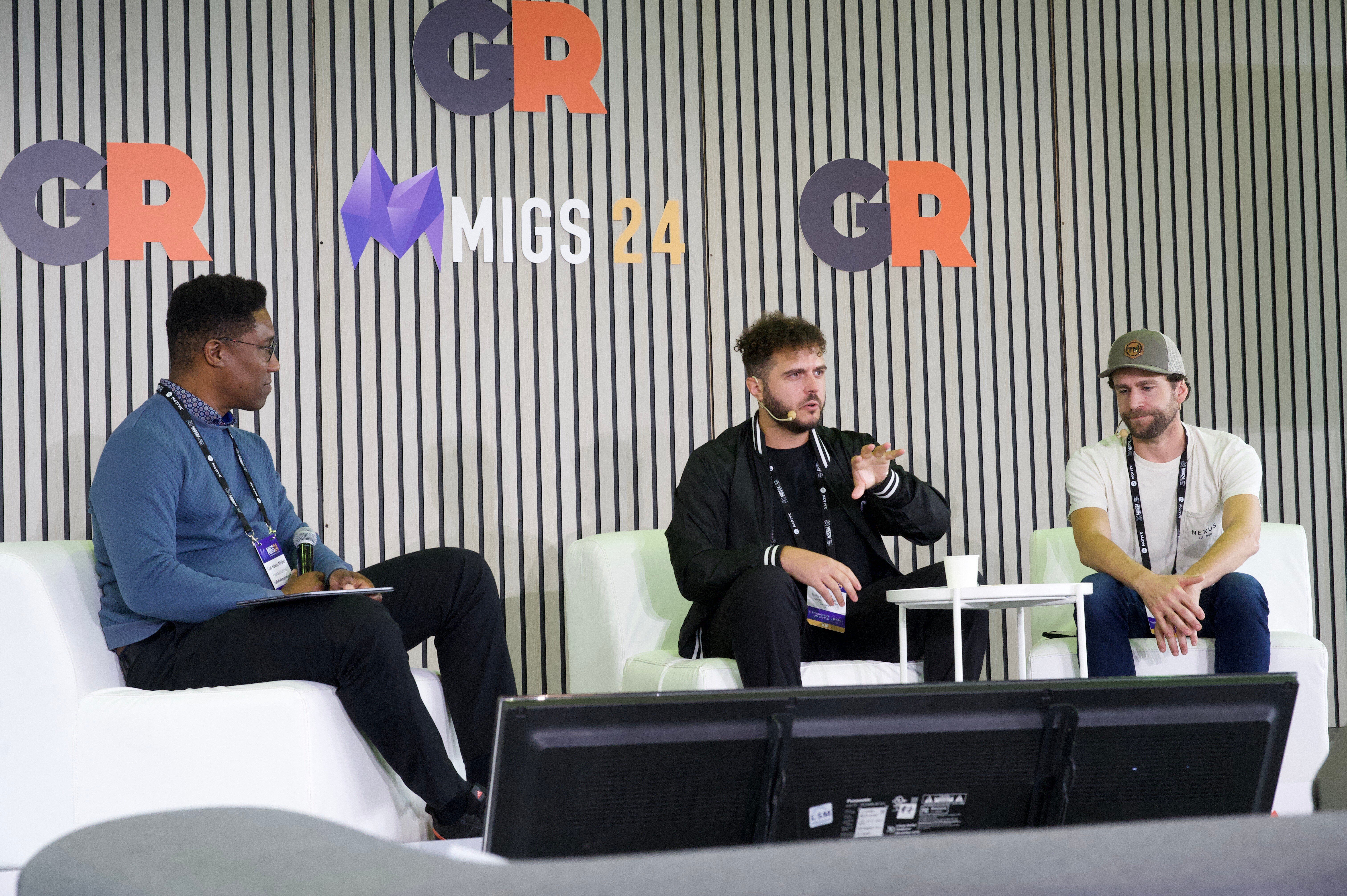 Creator Programs for Growth, Philippe-Olivier Crepin, Carl-Edwin Michelle, and Travis Neiderhiser - Photo taken by Astrid Rousselin, all rights to GameRebellion.
Creator Programs for Growth, Philippe-Olivier Crepin, Carl-Edwin Michelle, and Travis Neiderhiser - Photo taken by Astrid Rousselin, all rights to GameRebellion.
The panellists were unanimous on one point: the timing to start a creator program is as early as possible. “You might think it’s only needed at launch,” explained Neiderhiser, “but getting creators involved early on provides invaluable feedback for your game development.” Crepin added, “Social interaction, community engagement, and even a bit of competition can shape the game pre-launch through creator insights.” This playtesting feedback allows developers to refine the experience before it hits the market.
The Value of Continuous Engagement
The discussion highlighted that creator programs shouldn’t stop at launch. It’s about nurturing long-term relationships: keeping creators engaged with updates, new content, and opportunities to collaborate post-launch. “The relationship doesn’t end when the game goes live,” noted Michelle. “You need to keep creators in the loop, update them on what’s coming next, and ensure they remain invested in your game’s journey.”
As a compelling example, they pointed to Fortnite’s revenue-sharing model with top creators like Ninja; and Supercell’s content creator programs. Supercell goes as far as giving creators early access to developer resources and release schedules, allowing them to prepare content in advance. By sharing assets like battle passes and involving creators in future updates, these companies have mastered the art of fostering continuous engagement.
Focus on Relationships, Not Just Reach
One of the most insightful takeaways came from Crepin: “Creators are people; treat them well, and you’ll see a solid ROI.” The panel emphasized that it’s not always about partnering with the biggest influencers; instead, focus on building relationships with loyal, passionate creators who are genuinely invested in your game. These creators can drive community growth and player retention more effectively than chasing larger names who may not be as engaged.
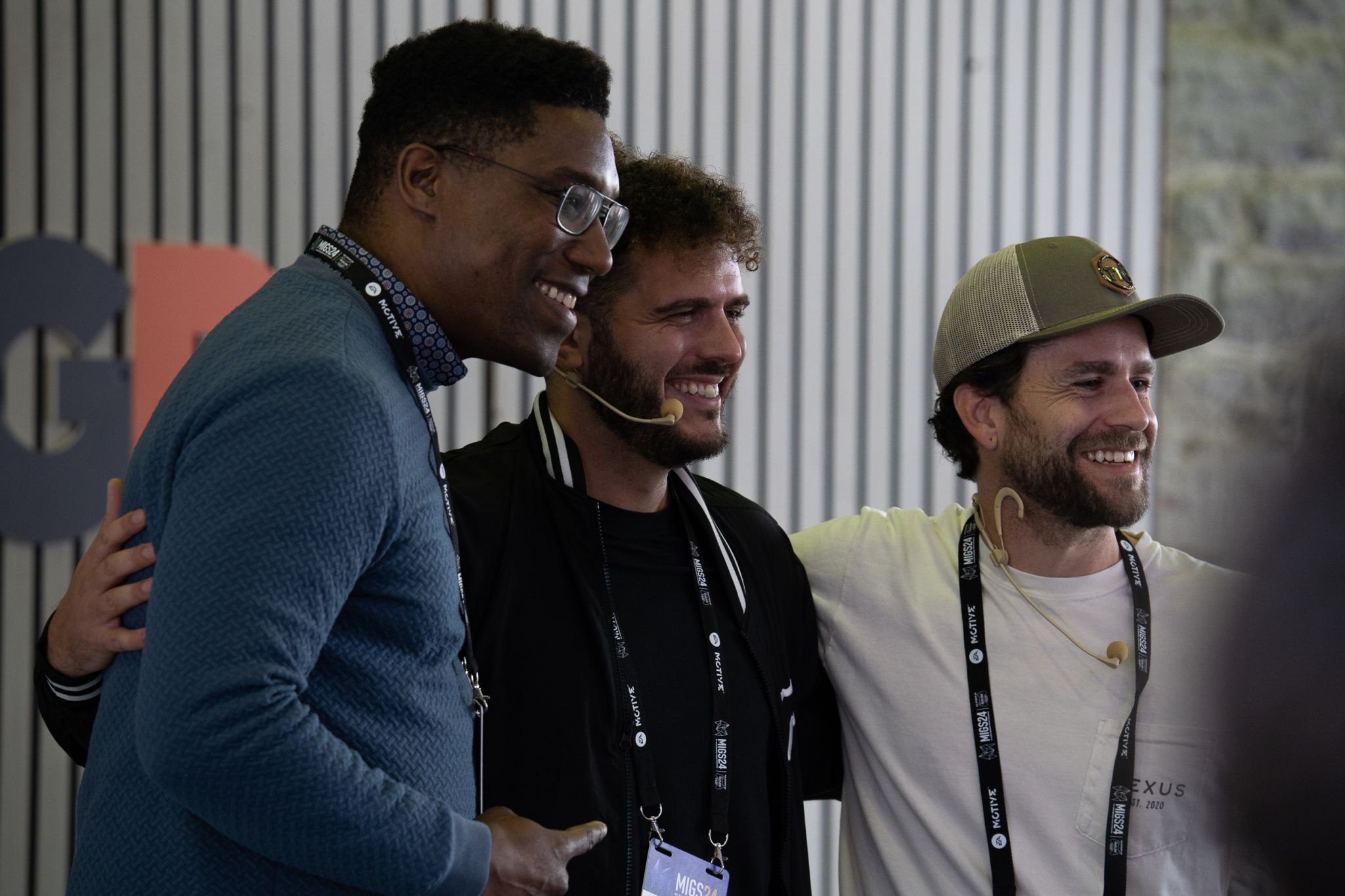 Philippe Olivier Cépin (center) at the Content Creator Program for Growth panel, with Carl-Edwin Michelle (left), and Travis Neiderhiser (Right). Photo taken by Lézard Agence.
Philippe Olivier Cépin (center) at the Content Creator Program for Growth panel, with Carl-Edwin Michelle (left), and Travis Neiderhiser (Right). Photo taken by Lézard Agence.
Crepin emphases, “Big names might bring instant fame, but it’ll fade away with their next partnership. A creator who truly loves your game can drive growth ten times more in the long run. It’s about the big picture, not just a short-term gain.”
The key message was clear: creator programs can be a game-changer, especially for indie developers, if approached with intentionality and mutual respect. As the panelists stressed, investing in these relationships early and maintaining them post-launch can significantly boost player retention, reactivation, and ultimately, the game’s long-term success.
Curious to learn more about how to leverage creator programs to grow your game? Check out our full article on the best strategies shared during MIGS 2024. 🚀 Discover more.
Trauma Bonding: The Evolution of The Outlast Trials
The panel on The Outlast Trials offered an inside look at how the beloved horror franchise evolved into a multiplayer experience while retaining its signature tension. Led by Philippe Morin, Alex Charbonneau, and Rosemarie Sarno, the discussion centered on the challenges of creating cooperative horror without losing the series’ intense atmosphere.
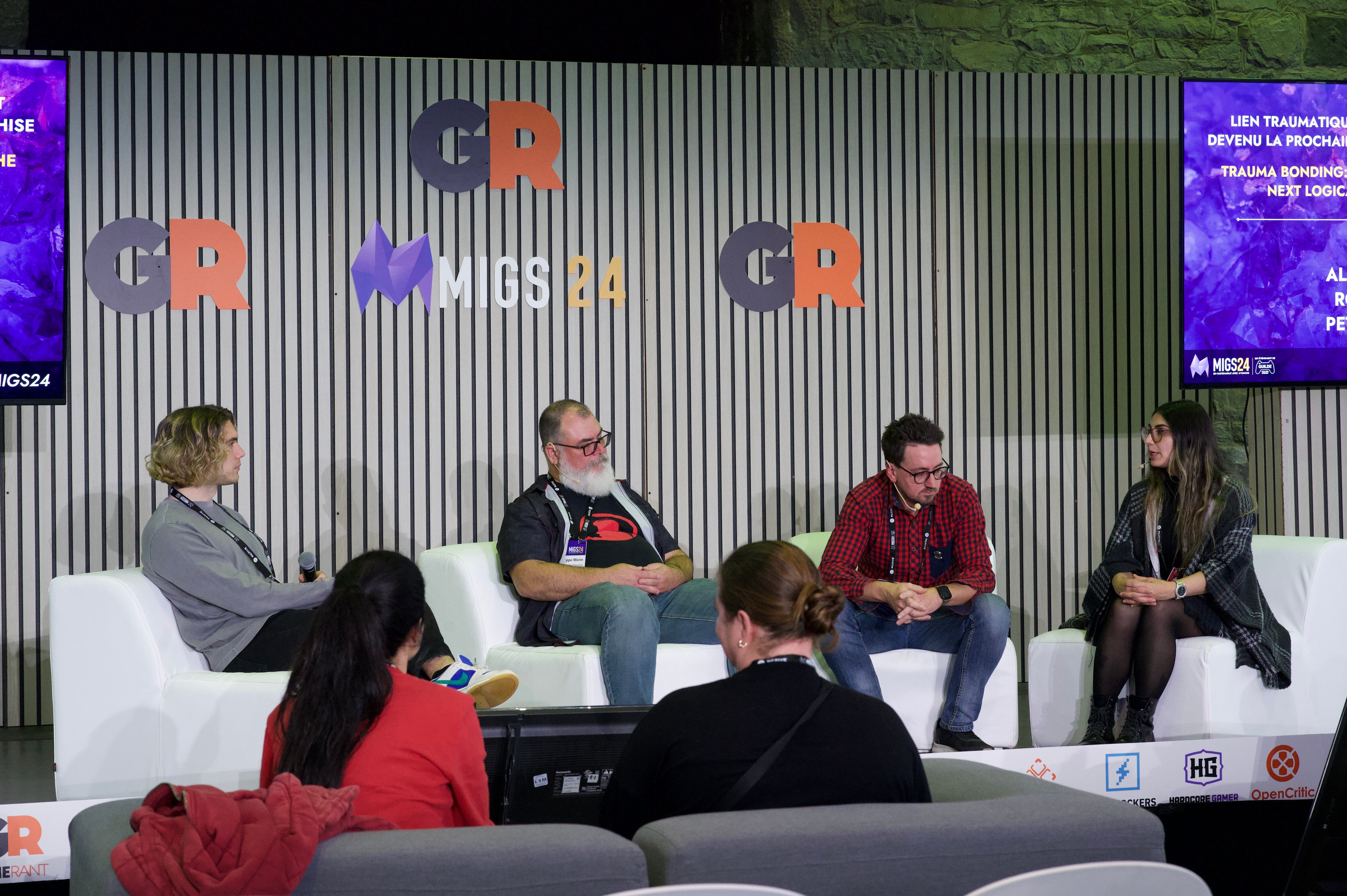 Trauma Bonding: How the Outlast Trials Became the Next Logical Evolution in the Franchise led by Philippe Morin, Alex Charbonneau, and Rosemarie Sarno - Photo taken by Astrid Rousselin, all rights to GameRebellion.
Trauma Bonding: How the Outlast Trials Became the Next Logical Evolution in the Franchise led by Philippe Morin, Alex Charbonneau, and Rosemarie Sarno - Photo taken by Astrid Rousselin, all rights to GameRebellion.
“After Outlast 2, we needed a break,” Morin shared. “It took us months to return to the Outlast universe, but we came back with a twist.” The team aimed to reinvent the game with co-op gameplay where players can split up or regroup, adding new layers of tension. Charbonneau described Trials as “a weird game; it’s co-op, but you might spend an hour solo before rejoining your team.”
Early feedback was vital. After a closed beta, the team received over 40,000 survey responses with an impressive “fun rating” of 4.8/5. “The feedback showed us players wanted more than just five trials; they wanted reasons to keep coming back,” Sarno noted. This led to transforming Trials into a live service game with continuous updates, DLCs, and cosmetics.
The game’s progression system and focus on community engagement were essential for replayability. “We’re very close to our community, and we listen carefully to what they want,” Morin emphasized. “It’s about making the game experience the best it can be, but we also have to keep some things under wraps—it’s a horror game, after all. We need to maintain the mystery.” This delicate balance of transparency and secrecy has helped The Outlast Trials maintain its intrigue while building trust with its players.
Creating a Narrative Within Chaos
Designing a narrative without relying on heavy scripting was another challenge. “Everything narrative needs to happen organically. It’s like a queue at Disney— you build the story in the environment, in the small details, rather than forcing players through cutscenes.” said Charbonneau. This approach allowed for creative storytelling while keeping gameplay fluid.
Sarno explained, “In Outlast, the narrative is hidden in the gameplay, leaving players to piece together the story. But in Trials, we’ve added the sleep room— a place where players can connect with their teammates, personalize their space, and get deeper insights into the villains’ motives.”
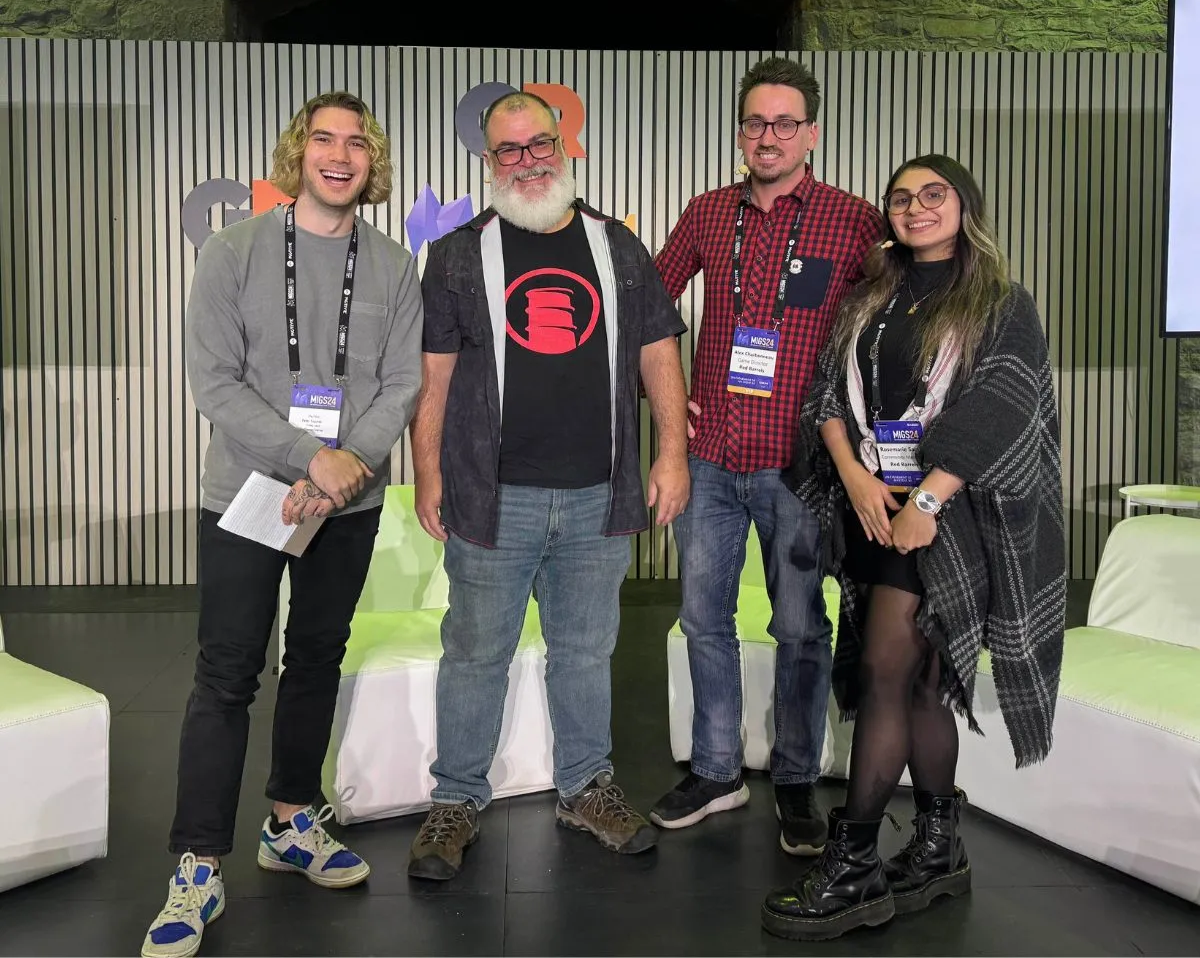 Trauma Bonding: How the Outlast Trials Became the Next Logical Evolution in the Franchise led by Philippe Morin, Alex Charbonneau, and Rosemarie Sarno.
Trauma Bonding: How the Outlast Trials Became the Next Logical Evolution in the Franchise led by Philippe Morin, Alex Charbonneau, and Rosemarie Sarno.
The sleep room also became a surprising hit with streamers, who initially downloaded the game to play the trials but ended up spending hours on the mini-games. “The Armstrong mini-game was actually created by one of our developers at a bar,” Sarno revealed. “Now, the sleep rooms are full of activities that give players a reason to log in every day.”
When asked about the trend of turning traditionally single-player games into multiplayer experiences, Morin was candid: “We started with the idea of four players, but quickly realized that letting players explore solo, in pairs, or in groups of three added a chaotic, stressful layer to the game.”
But for fans of the original Outlast series, there’s also good news: “If we ever do an Outlast 3, it’s going to be a single-player experience,” Morin confirmed, hinting that the franchise may still return to its roots in the future.
Monetization Strategy: Embracing Live Service
Unlike its predecessors, which followed a traditional premium pricing model, The Outlast Trials is embracing a live service format with DLC packs and cosmetic items. “In the past, players created their own co-op experiences by passing the controller after each death,” Morin recalled. “With Trials, we’ve built on that spirit to create something new and interactive.”
The shift to a live service model allows the game to continuously evolve based on community feedback, ensuring that players have new content to look forward to. “We’re committed to keeping this game alive with regular updates, and the community’s response has been overwhelmingly positive,” Sarno concluded.
The Outlast Trials panel is yet another proof of the importance of community-driven development, the value of feedback loops, and the potential of live service games to keep players engaged long-term. As Sarno aptly put it, “Trials are still experiments, and that’s the beauty of it. We’re not afraid to try new things, and that’s what keeps our community coming back for more.”
It Takes a Village: Narrative Design in Disney Dreamlight Valley
In one of the most captivating panels, titled It Takes a Village: Bringing Narrative to Disney Dreamlight Valley, Creative Director Josh Labelle of Gameloft Montreal delved into the intricate art of bringing beloved Disney characters like Buzz Lightyear and Scar to life in Disney Dreamlight Valley. He shared the challenges and triumphs of crafting narrative experiences within the framework of a life-simulation game while working with iconic intellectual properties (IPs).
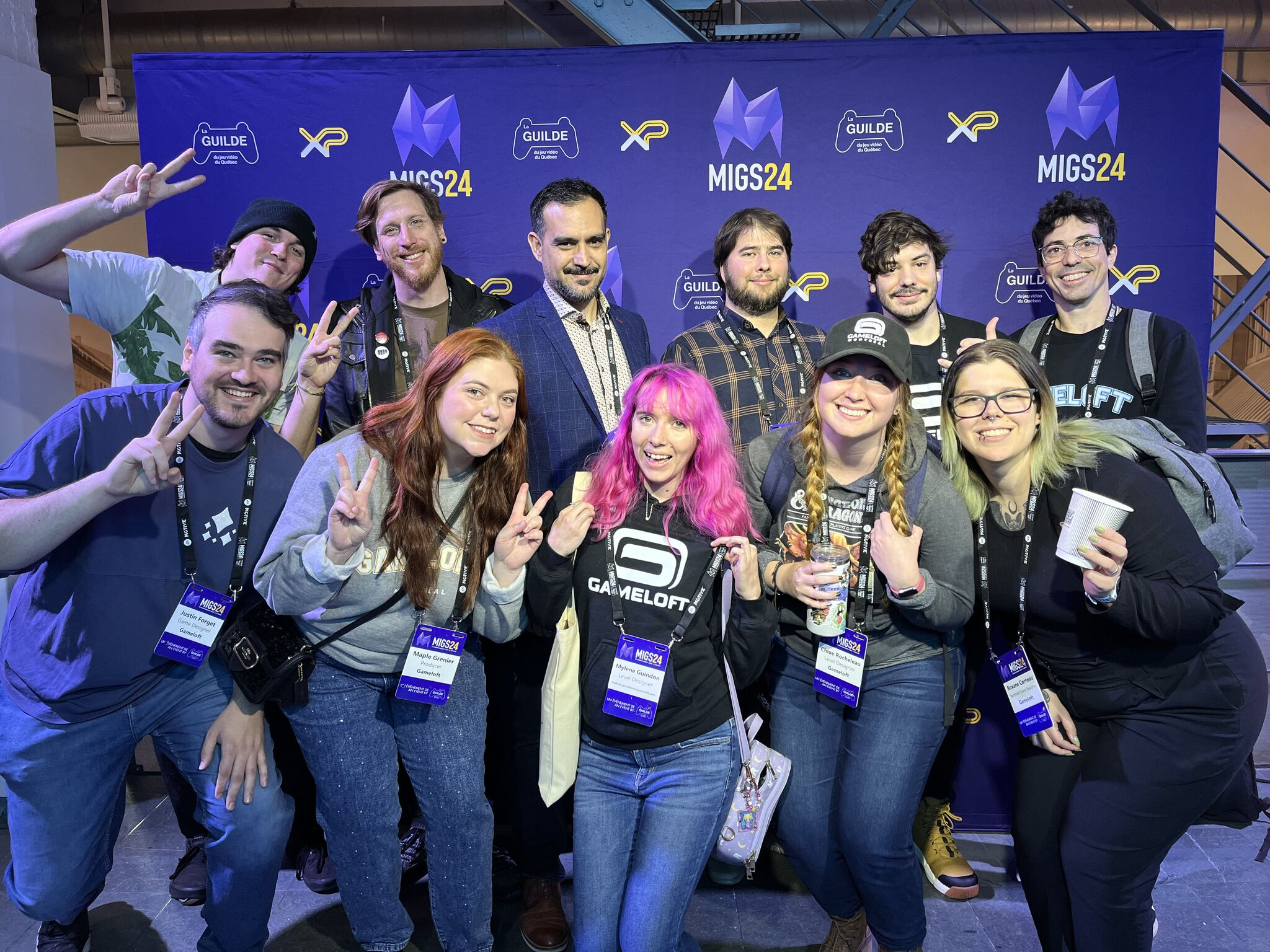 Gameloft team posing at MIGS 2024 - MIGS official Linkedin posts.
Gameloft team posing at MIGS 2024 - MIGS official Linkedin posts.
Labelle emphasized the delicate balance required when working with established IPs. “You have to respect the source material,” he explained. “Fans are deeply attached to these characters—they know every detail, every nuance.”
For the team, this meant diving into fan communities, exploring fanfiction, and even studying merchandise to understand what fans cherish most. “What would fans be disappointed not to see?” he posed. This became a guiding question in the creative process throughout the game development.
Rapid Updates and Continuous Engagement
“Hardcore fans are your best resource,” Labelle shared. “Listen to what they love, what they imagine, and where they want these stories to go.” By tuning into fan expectations, the team ensured that they were not just delivering a game but expanding a universe that fans could feel truly connected to.
What truly sets Disney Dreamlight Valley apart isn’t just the shared universe of beloved characters, but the speed at which new content is delivered. “We’ve implemented 13 free content updates already,” Labelle proudly noted. This rapid cadence keeps the game fresh and ensures players always have something new to explore. The team’s close relationship with Disney allows them to seamlessly integrate updates that surprise and delight players.
Building a Strong Relationship with the Licensor
Navigating a partnership with Disney required constant collaboration. “Developing a strong relationship with the licensor was crucial,” Labelle explained. By working closely with Disney, the team could ensure that every new addition was not only faithful to the characters but also aligned with the brand’s vision.
For indie studios aspiring to work with established characters or themes, this panel was a masterclass in balancing authenticity with creativity. As Labelle put it, “It’s not just about telling a story— it’s about honouring the characters that fans have loved for years, while still finding new ways to surprise them.”
The Value of Independence: Insights from Behaviour Interactive
At MIGS, Canada’s largest game developer, Behaviour Interactive, led a thought-provoking panel: A Fireside Chat on Independence with Behaviour Interactive, on the power of independence in the gaming industry. The session, featuring CEO Chris Chancey (Manavoid Entertainment) and Senior VP at Behaviour Interactif, Stephanie Marchand, delved into how maintaining creative control has allowed Behaviour to stay agile and true to its vision, even as it scales.
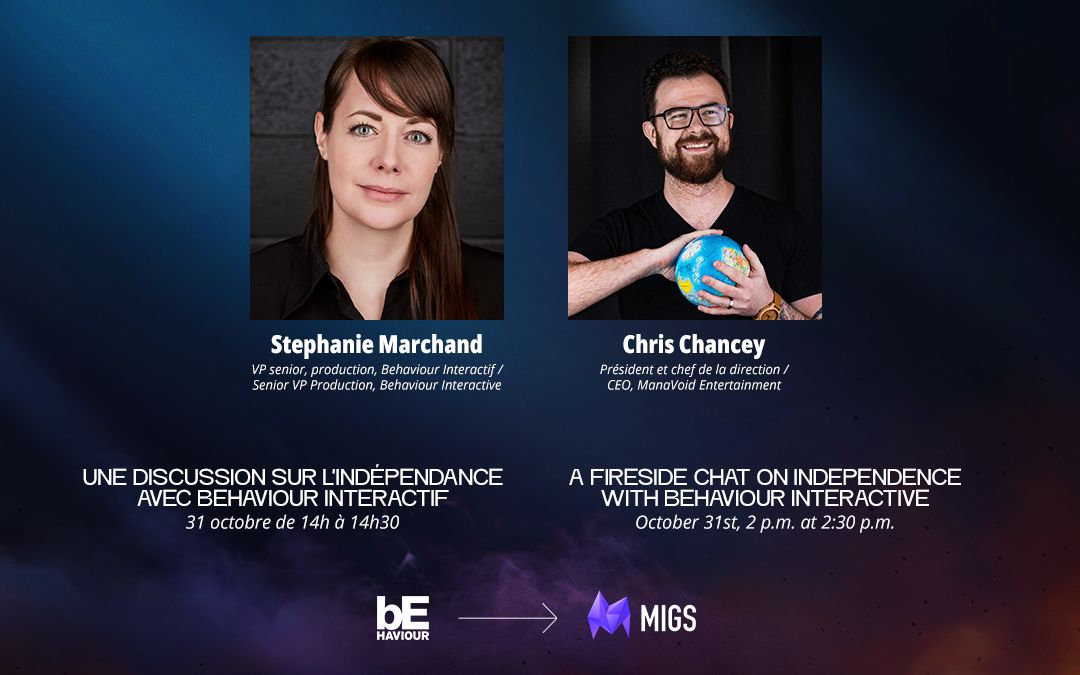 A Fireside Chat on Independence with Behaviour Interactive, led by Stephanie Marchand, Senior VP at BE, and Chris Chancey CEO of Manavoid Entertainment.
A Fireside Chat on Independence with Behaviour Interactive, led by Stephanie Marchand, Senior VP at BE, and Chris Chancey CEO of Manavoid Entertainment.
Redefining Indie: What Indie Labels Really Means
While Behaviour has grown significantly, expanding from 500 employees pre-Dead by Daylight to over 1,200 after its success, the company still considers itself independent. “Being indie means something different for us,” Marchand explained.
“The CEO owns more than 50% of the company, and all creative decisions are made internally. No external investors dictate our vision.” This control has enabled Behaviour to remain nimble, fostering a culture where decisions are made quickly and creatively.
“We’re efficient and people-driven,” Marchand continued. “Each morning, you come in knowing you’re going to build something exciting with your team. That’s what keeps us going.”
Balancing Creativity with Business Strategy
Behaviour’s journey wasn’t always smooth. “We had our share of flops before Dead by Daylight became a hit,” admitted Marchand. But the team learned from those experiences. “We create great games, but we also run the company like a business.” This balance between creativity and strategic business decisions has been a cornerstone of Behaviour’s growth.
Their strategy includes a mix of work-for-hire projects and in-house game development to maintain financial stability. “It’s all about balancing those two elements,” Marchand noted.
Expanding Horizons: Acquisitions and Transmedia
Behaviour’s recent acquisition of Red Hook Studios, a Vancouver-based game developer, is part of its strategy to grow its footprint while staying aligned with its creative vision. “We’re not just focused on developing games— we’re looking at expanding into transmedia,” Marchand shared. This includes ventures like the upcoming Dead by Daylight movie and the quirky spin-off dating sim Hooked on You, which leverages the game’s beloved villains.
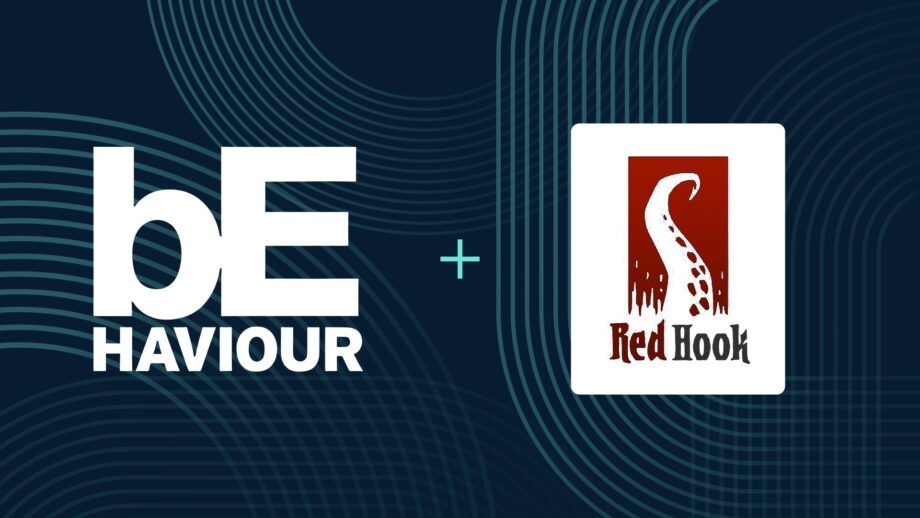 Behaviour Interactive acquires Red Hook Studios, written by Andrey Zubov and published on Invest game on 01 Oct 2024.
Behaviour Interactive acquires Red Hook Studios, written by Andrey Zubov and published on Invest game on 01 Oct 2024.
Despite their success, Behaviour is cautious about entering the publishing space. “We would love to publish other studios’ games, but it’s a tough business,” said Chancey. “The mobile market is changing, and acquisition strategies are constantly evolving. It’s something we aspire to, but we’re not quite there yet.”
Pushing Boundaries with Horror and IPs
Known for their love of horror, Behaviour continues to expand the universe of Dead by Daylight. “Every horror character goes through our universe,” Marchand said, hinting at collaborations with iconic IPs like Iron Maiden, Nicolas Cage, and Alien. “There’s a huge fan base that keeps asking for more. We’re always looking for ways to grow the franchise.”
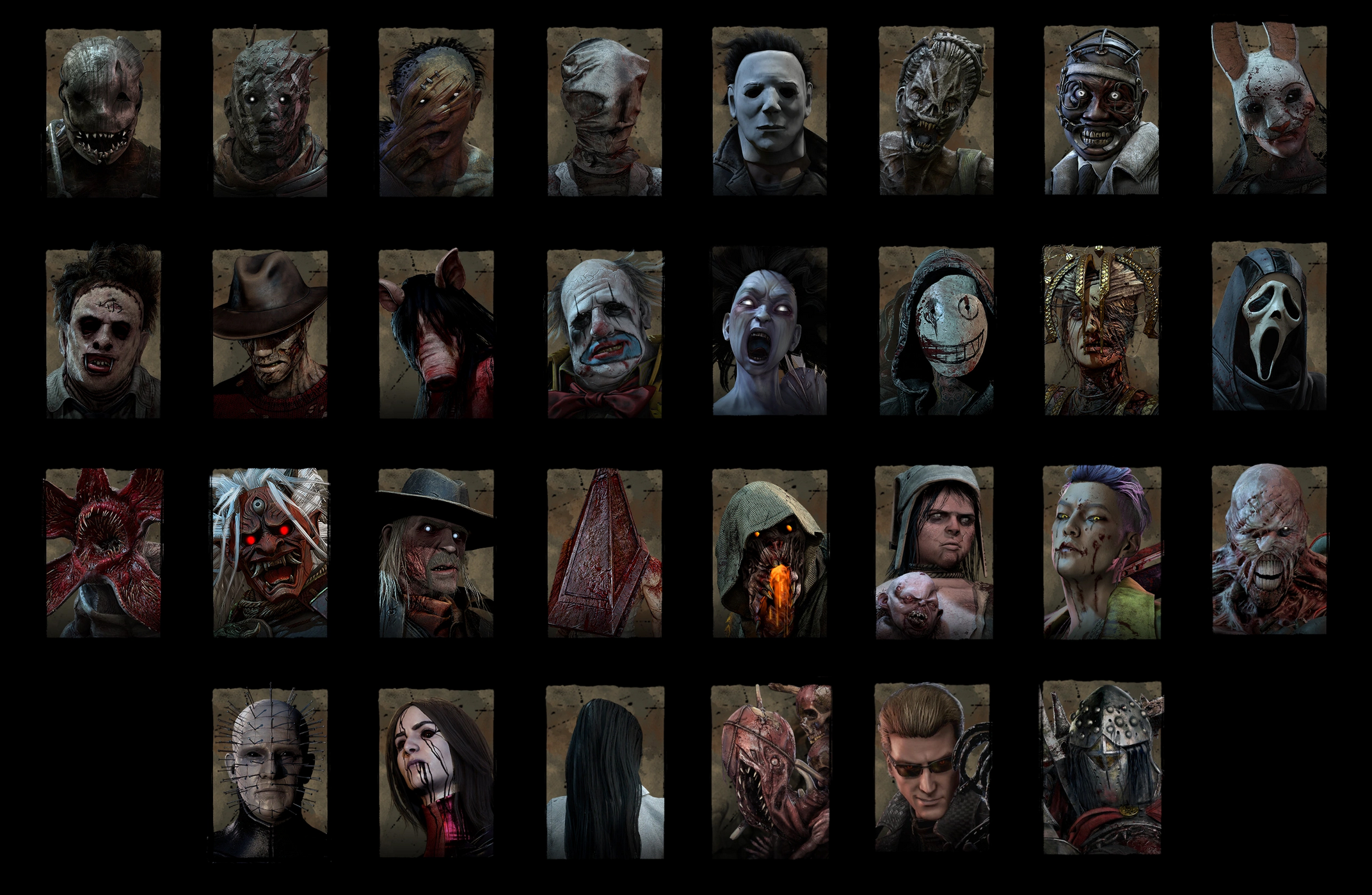 Which is the weakest killer without perks and add-ons? - by Behaviour Interactive, published in April 2023.
Which is the weakest killer without perks and add-ons? - by Behaviour Interactive, published in April 2023.
The offered valuable insights for indie developers looking to expand without compromising their vision. As Marchand concluded, “Independence doesn’t mean being small, it means having the freedom to stay true to who you are, no matter how big you grow.”
“We’re aware of the competition, but we’re far more focused on what we can offer players,” said Marchand. “It’s about maximizing what we can deliver with what we have. We’re not really trying to mirror others because our gameplay mechanics are quite unique.”
Final Reflections: Strengthening Our Commitment to Indie Developers
And that’s a wrap! There’s so much more we could dive into, but this article would never end. Every panel offered fresh insights and unique perspectives, leaving us with plenty to think about. While we couldn’t see or share everything we wanted, there’s always next year to look forward to!
Leaving MIGS 2024, we’re filled with a renewed sense of purpose. The event served as a powerful reminder of the creativity, resilience, and passion driving the gaming industry forward.
At GameRebellion, our commitment to supporting indie developers has never been stronger—whether through partnerships, collaborations, or delivering the resources they need to succeed. Here’s to what’s next!
 The infamous (and beloved) Redbull fridge was appreciated (and needed) by many attendees!
The infamous (and beloved) Redbull fridge was appreciated (and needed) by many attendees!
A heartfelt thank you to everyone who visited our booth and shared their stories. Your enthusiasm and creativity made this event unforgettable. We can’t wait to see how these connections will grow in the coming year. Here’s to a shared love for games, to resilience, and to the incredible journey ahead.
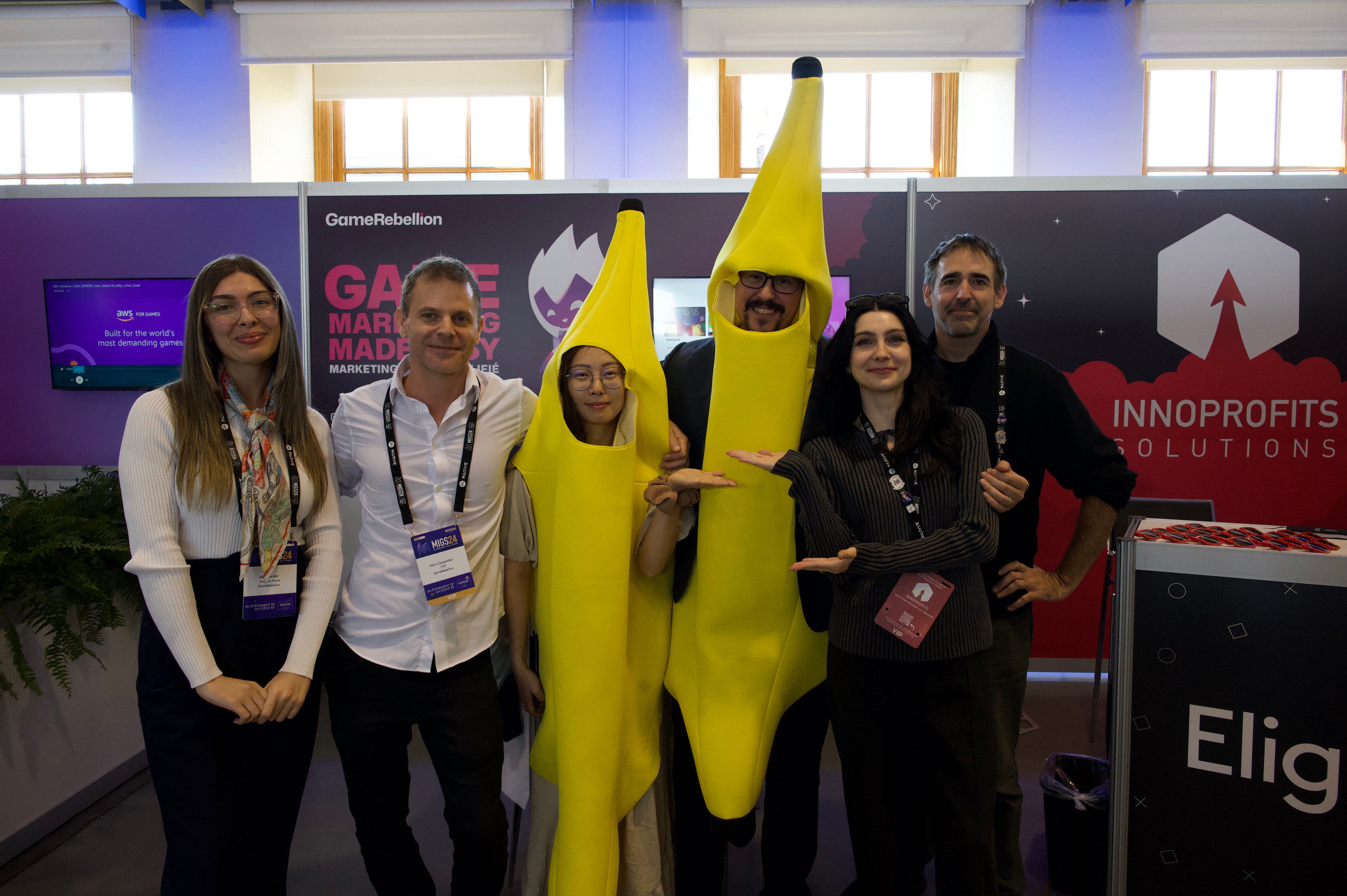 GameRebellion team posing with Jason Lepine - Photo taken by Astrid Rousselin, all rights to GameRebellion.
GameRebellion team posing with Jason Lepine - Photo taken by Astrid Rousselin, all rights to GameRebellion.
We’ll see you at MIGS 2025 at the new location au Grand Quai (bigger space and bigger scale) — See you next year!











